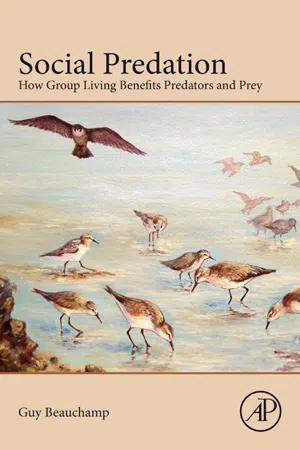
- 336 pages
- English
- ePUB (mobile friendly)
- Available on iOS & Android
About this book
The classic literature on predation dealt almost exclusively with solitary predators and their prey. Going back to Lotka-Volterra and optimal foraging theory, the theory about predation, including predator-prey population dynamics, was developed for solitary species. Various consequences of sociality for predators have been considered only recently. Similarly, while it was long recognized that prey species can benefit from living in groups, research on the adaptive value of sociality for prey species mostly emerged in the 1970s. The main theme of this book is the various ways that predators and prey may benefit from living in groups. The first part focusses on predators and explores how group membership influences predation success rate, from searching to subduing prey. The second part focusses on how prey in groups can detect and escape predators. The final section explores group size and composition and how individuals respond over evolutionary times to the challenges posed by chasing or being chased by animals in groups. This book will help the reader understand current issues in social predation theory and provide a synthesis of the literature across a broad range of animal taxa.- Includes the whole taxonomical range rather than limiting it to a select few- Features in-depth analysis that allows a better understanding of many subtleties surrounding the issues related to social predation- Presents both models and empirical results while covering the extensive predator and prey literature- Contains extensive illustrations and separate boxes that cover more technical features, i.e., to present models and review results
Frequently asked questions
- Essential is ideal for learners and professionals who enjoy exploring a wide range of subjects. Access the Essential Library with 800,000+ trusted titles and best-sellers across business, personal growth, and the humanities. Includes unlimited reading time and Standard Read Aloud voice.
- Complete: Perfect for advanced learners and researchers needing full, unrestricted access. Unlock 1.4M+ books across hundreds of subjects, including academic and specialized titles. The Complete Plan also includes advanced features like Premium Read Aloud and Research Assistant.
Please note we cannot support devices running on iOS 13 and Android 7 or earlier. Learn more about using the app.
Information
Antipredator Ploys
Abstract
Keywords
3.1 Introduction
3.2 Antipredator Ploys
3.2.1 Collective Detection
3.2.1.1 Signals Used for Collective Detection
Table of contents
- Cover image
- Title page
- Table of Contents
- Copyright
- Preface
- Part A: Predators
- Part B: Prey
- Part C: General Considerations
- Conclusion
- References
- Index
- Colour Plates